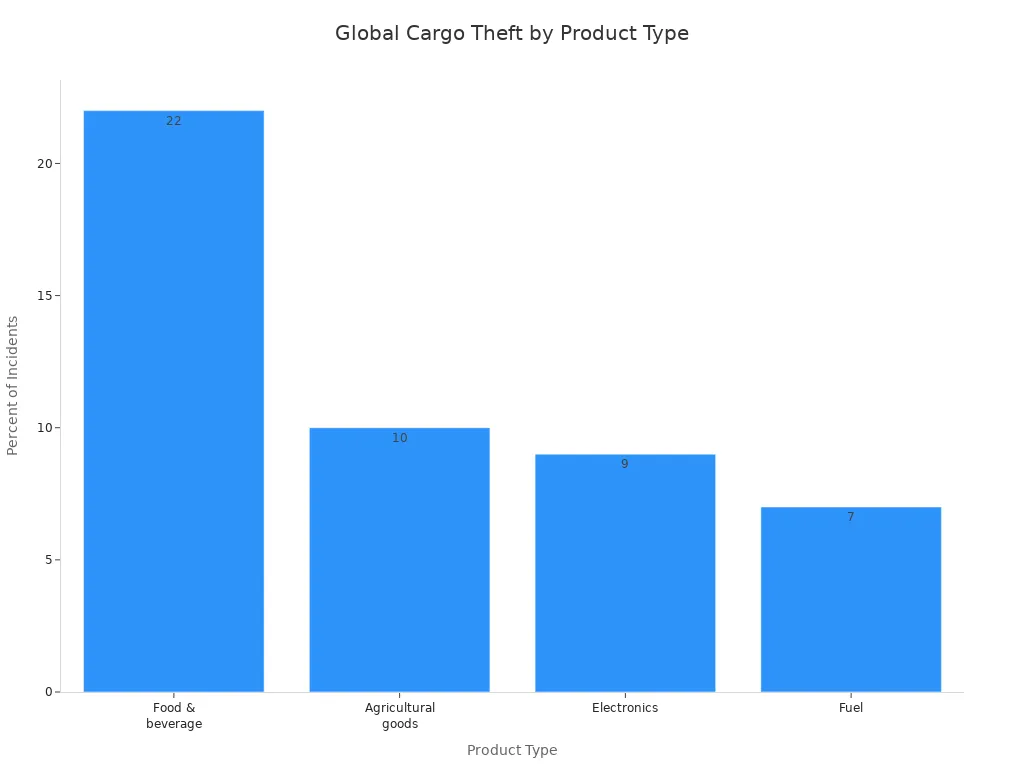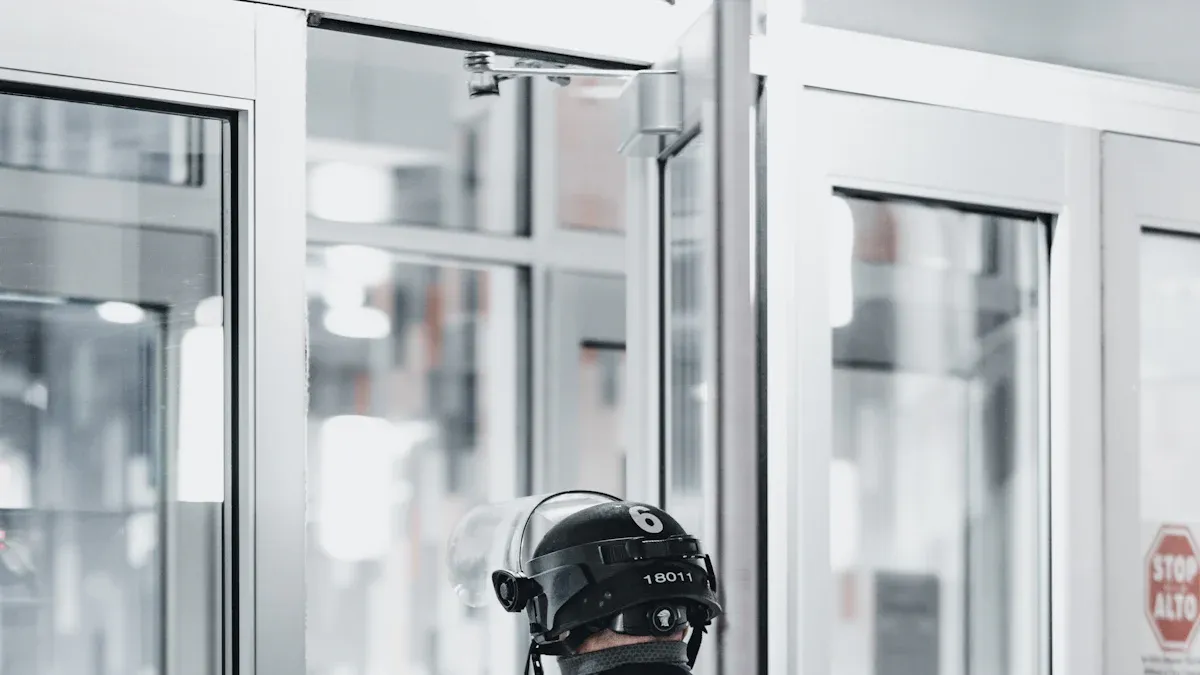Prevent Cargo Theft and Secure Your Freight

Prevent Cargo Theft requires you to act quickly and stay vigilant. Recent reports show a 49% surge in U.S. cargo thefts, costing the supply chain up to $35 billion each year. You face evolving threats, from cyber scams to hijackings, with only 10% of cases resulting in arrests.
Region | Common Theft Types & Targets | Notable Trends & Responses | |
|---|---|---|---|
Global | Food & beverage: 22% of incidents; 41% in transit | Hijackings: 21%; vehicle theft: 20% | Rise in cyber scams, insider collusion |
North America | Strategic theft, cyber vulnerabilities | Legislative action, tech upgrades | |
Europe & UK | Warehouses: 41% targeted | Slash-and-grab, parked vehicle theft | Tech-enabled thefts, parking upgrades |
Asia | Piracy: 107 incidents; India: 63% | Insider threats, facility theft | Violence, fictitious pickups |

JUSDA’s innovative approach combines practical steps with intelligent platforms like JusLink. You should evaluate your security protocols and proactively update them to protect your freight.
Key Takeaways
Use strong physical and digital security measures like locks, cameras, GPS tracking, and cybersecurity to protect your cargo.
Vet all partners carefully by checking their credentials, insurance, and reputation to reduce fraud risks.
Plan routes and parking carefully to avoid high-risk areas and always park in secure, well-lit locations.
Train drivers and staff regularly to spot suspicious activity and follow security protocols.
Leverage advanced technology like AI, real-time tracking, and geofencing to monitor shipments and respond quickly to threats.
Prevent Cargo Theft Strategies
Information Security
You face a growing number of threats in logistics, from physical theft to cyberattacks. To prevent cargo theft, you must protect both your physical assets and your digital information. Start by installing video surveillance cameras at loading docks, warehouses, and parking areas. These cameras deter theft and help you monitor cargo at all times. Use GPS tracking devices on your shipments. Real-time location monitoring lets you respond quickly if something goes wrong.
Physical security measures also include high-quality seals and locks on containers and trucks. Only allow authorized personnel to access cargo areas. Enforce strict access control systems and keep detailed records of everyone who enters or exits.
You should not overlook cybersecurity. Use multi-factor authentication and encrypt sensitive data. Update your software regularly to close security gaps. Train your employees to spot phishing attempts and practice good cyber hygiene.
Tip: Build a strong security culture. Encourage your team to report suspicious activity and always follow security protocols.
Combine these steps with advanced technologies. IoT sensors can detect tampering or unauthorized access. Blockchain technology secures shipment documentation and reduces fraud. Regularly review and update your security protocols to stay ahead of new threats. By taking these actions, you create a multi-layered defense to prevent cargo theft.
Partnership Vetting
Choosing the right partners is critical if you want to prevent cargo theft. You need to verify the reliability of every broker, carrier, and logistics partner before you trust them with your freight.
Check that each partner complies with federal and state regulations. Confirm their operating authority and review their driver qualification files.
Use technology like transportation management systems and electronic data interchange to track shipments and verify vehicle identification numbers.
Assess financial stability by reviewing credit reports and payment histories. Make sure your partners have robust insurance coverage by requesting certificates directly from insurers.
Research company reputation and industry affiliations. Look for memberships in respected organizations such as TIA or NASSTRAC.
Regularly verify contact information against official records to prevent identity theft. Call directly and match email addresses with registered data.
Use private load boards with enhanced security features. Avoid choosing partners based only on the lowest rates, as this can increase your risk.
Maintain detailed records of trucks, including DOT numbers, VINs, and photos. Always verify driver license plates and truck details at pickup.
Build relationships with trusted carriers and foster open communication. Hold payments if you suspect double-brokering until you complete verification.
Note: JUSDA’s industry expertise helps you develop comprehensive cargo security plans. Our team uses advanced vetting tools and real-time monitoring to ensure your partners meet the highest standards.
By following these steps, you reduce the risk of fraud and strengthen your ability to prevent cargo theft.
Secure Communication
You must protect your shipment details from cybercriminals and unauthorized access. Secure communication is a key part of any strategy to prevent cargo theft.
Use encryption, advanced firewalls, and intrusion detection systems to safeguard sensitive logistics data.
Employ AI-powered real-time monitoring and centralized control towers to detect and stop cyber threats before they cause harm.
Train your staff to recognize and respond to cybersecurity risks. Ongoing education keeps your team alert and ready.
Ensure your vendors follow strict compliance requirements. This reduces third-party vulnerabilities.
Adhere to cybersecurity regulations and standards such as FMCSA guidelines, GDPR, and ISO 27001.
Use advanced tracking technologies like GPS devices and RFID tags for shipment visibility.
Implement electronic cargo seals and secure communication channels to monitor cargo movement during transit.
Enforce strict access controls and background checks for anyone handling cargo.
Tip: Regularly review your communication protocols and update them as new threats emerge. This keeps your defenses strong and your cargo secure.
When you combine secure communication with strong information security and careful partner vetting, you create a powerful strategy to prevent cargo theft and protect your freight.
Driver and Carrier Best Practices

Secure Parking
You play a vital role in keeping cargo safe during transit. Always choose well-lit, gated, and monitored parking lots or garages. These locations help deter thieves and make it easier to watch over your freight. When you park in secure areas, you reduce the chance of theft. If you notice any suspicious activity or experience a theft, report it to local authorities right away. Quick reporting helps increase area monitoring and supports prevention efforts. Secure parking is a simple but powerful way to prevent cargo theft.
Tip: Never leave your vehicle unattended in isolated or poorly lit areas, even for a short time.
Route Planning
Careful route planning helps you avoid high-risk areas and keeps your cargo safe. Use GPS tracking and route optimization tools to monitor your shipment’s location at all times. Try to avoid routes that pass through theft-prone regions, especially at night or during low-traffic hours. Dynamic route planning lets you adapt to real-time data and avoid theft hotspots. You can also alternate routes and delivery schedules to prevent predictability. Analyzing route safety and choosing alternative paths that still meet delivery deadlines lowers your risk. Recognize that cargo theft often happens near major transportation hubs and in busy urban areas, especially during holidays or weekends. By planning ahead, you can prevent cargo theft and keep your shipments secure.
Avoid parking in isolated areas by using secured truck stops.
Change routes and delivery times to stay unpredictable.
Training and Protocols
Proper training prepares you to handle threats and protect your cargo. Team driving reduces the time vehicles are left unattended. Regular training programs teach you to stay alert and spot suspicious activity. You should always follow company policies on cargo security, reporting, and route planning. Supervise loading and unloading, and check all cargo documentation. Use advanced security technology like GPS tracking and geofencing as part of your training. Crisis management training helps you respond quickly if theft occurs. Encourage immediate reporting of anything unusual during your route. Building a culture of safety and sharing best practices with your team strengthens your defense against theft.
Alert: Your safety comes first. Training must prepare you to handle high-risk situations and protect both yourself and your cargo.
Physical and Facility Security

Locks and Hardware
You need strong locks and hardware to protect your cargo from theft. High-security padlocks, such as ABLOY® and ENFORCER® locks, resist picking, drilling, and harsh weather. These locks work well on containers, trailers, and doors. You can use different types of locks for each part of your vehicle or facility:
Air brake locks and air cuff locks stop unauthorized movement of trucks.
King pin locks prevent trailer theft by blocking unauthorized hookups.
Bulkhead, swing door, and roll-up door locks secure entry points.
Seal guard locks protect cargo seals from tampering.
Master key systems help you manage access and reduce key duplication risks.
Automatic vehicle restraints and rotating hook-style restraints add another layer of security. These devices physically secure trailers at docks and re-lock if tampered with. Real-time trailer presence monitors and cameras help you watch for tampering or theft attempts. When you use these tools, you create strong barriers that help prevent cargo theft.
Tip: Choose locks and hardware built for extreme environments, such as deserts or frozen routes, to ensure reliable protection year-round.
Warehouse Security
You must secure your warehouse to keep cargo safe during storage. Advanced security systems combine video surveillance, motion detectors, alarms, and perimeter lighting. These tools make intrusions risky and visible. Real-time monitoring and immediate alerts let you respond quickly to any breach.
Install high-quality cameras in warehouses, yards, and parking areas.
Use intrusion detection systems and alarms to spot unauthorized entry.
Add physical barriers like fences and bollards to protect storage areas.
Conduct regular security audits to find and fix weak spots.
AI-enabled video management systems can analyze video feeds and alert you to suspicious activity. License plate recognition helps track vehicles entering and leaving your facility. These steps reduce theft risks and help you prevent cargo theft before it happens.
Access Control
Access control systems limit entry to only authorized people and vehicles. You can use network-based access control, mobile credentials, and vehicle access solutions to manage who enters your facility. Modern systems often include:
Keycards, PINs, or biometric readers for secure entry.
Integration with surveillance and intercom systems for extra coverage.
Cloud-based or on-premise management for flexibility.
Automated updates and cybersecurity enhancements to keep systems secure.
Access control systems keep detailed records of who enters and exits. This helps you track movement and investigate incidents. When you combine access control with strong locks and warehouse security, you build a powerful defense against theft.
Note: Regularly update access permissions and remove access for former employees to keep your facility secure.
Technology Solutions with JUSDA and JusLink
JUSDA helps you prevent cargo theft by using advanced technology. JusLink, JUSDA’s AI-driven platform, gives you powerful tools to protect your freight at every stage.
Real-Time Tracking
You can track your cargo in real time with GPS and IoT devices. This technology lets you see exactly where your shipment is at any moment. If someone tries to steal your cargo, you get instant alerts. You can even use remote engine immobilization to stop a stolen vehicle. Tamper-evident locks and Bluetooth trackers send warnings if someone tampers with your load. Many companies have recovered stolen goods within hours because of these tools. Real-time tracking also helps you spot route changes or delays, so you can act fast to prevent cargo theft.
Monitor cargo location 24/7
Get instant alerts for route changes or tampering
Recover stolen shipments quickly
Geofencing
Geofencing sets up virtual boundaries around safe zones, depots, or routes. When your vehicle enters or leaves these zones, you get an alert. This helps you stop unauthorized movements and keeps your cargo on approved routes. Geofencing also helps you follow local rules and avoid risky areas. You can update geofencing settings as threats change, making your security stronger.
Create virtual boundaries for vehicles and cargo
Receive alerts for unauthorized entry or exit
Ensure drivers follow planned routes
AI Risk Management
JusLink’s Risk Control Tower uses AI to watch over your supply chain. It collects and analyzes data from suppliers to customers. The system predicts risks, tracks inventory, and gives you real-time updates. AI and IoT work together to spot threats before they become problems. You get clear insights to make smart decisions and keep your cargo safe.
Metric | Value | Description |
|---|---|---|
Precision | 94.60% | Theft vulnerability detection accuracy |
Recall | 95.67% | Actual theft event identification |
F-Measure | 96.64% | Overall detection performance |
Error Reduction | 48% | Fewer detection errors |
Reliability | 94.48% | Consistent system performance |
Latency Rate | 7.44 s | Real-time analysis speed |
IoT, cloud computing, and big data give you end-to-end visibility. These tools help you act fast and prevent cargo theft before it happens.
Industry Collaboration and Networks
Security Associations
You strengthen your cargo security by joining leading industry associations. These organizations set standards, offer training, and provide resources that help you prevent theft. The National Motor Freight Traffic Association (NMFTA) gives you access to the Cybersecurity Cargo Crime Reduction Framework. This framework teaches you how to spot cyber theft red flags, improve your defenses, and respond quickly to threats. NMFTA shares practical tips, such as supervising goods during shipping, identifying theft hotspots, installing security devices, and verifying shipper identities.
The Transported Asset Protection Association (TAPA) offers certification programs for warehouses, distribution centers, and transport facilities. Certification ensures you meet minimum security requirements for drivers and facilities. You gain benefits like improved processes, skilled personnel, and stronger customer relationships. TAPA’s standards help you reduce theft and transportation crime across the supply chain.
You also find value in organizations like ISCPO and the Southwest Transportation Security Council. These groups promote security standards, conduct staff training, and share incident alerts. By participating, you stay informed about the latest threats and solutions.
Tip: Membership in security associations gives you access to expert advice, best practices, and a network of professionals dedicated to cargo protection.
Information Sharing
You reduce cargo theft by sharing information with your partners and law enforcement. Collaboration helps you spot trends, respond to incidents, and improve your security measures. Platforms like CargoNet connect you with other victims, business partners, and authorities. CargoNet’s 24/7 command center supports theft recovery and offers prevention training. You benefit from trend analytics and better communication with law enforcement, which increases recovery rates.
Shared platforms allow you to exchange real-time information about threats and suspicious activities. Advanced tracking and analytics help you detect anomalies and identify risks. Retailers and supply chain stakeholders use third-party vetting services and contractual obligations to ensure carrier legitimacy. Cross-functional teams within companies—such as asset protection, cybersecurity, and logistics—work together to understand and combat theft tactics.
You establish clear communication protocols and transparency among all partners. Regular audits and compliance checks help you find vulnerabilities and maintain high security standards. Training on secure parking, route planning, and compliance further reduces theft risk. Fleet management software supports these strategies and strengthens your supply chain resilience.
Share best practices and security initiatives.
Use technology to detect and respond to threats quickly.
Note: Strong networks and open communication make your supply chain more resilient and less vulnerable to cargo theft.
You can prevent cargo theft by combining advanced tracking, geofencing, tamper detection, and AI-driven platforms with strong physical security and thorough partner vetting. Regularly review and upgrade your security protocols to stay ahead of evolving threats. This layered approach, supported by JusLink from JUSDA, helps you adapt quickly and protect your freight. Take action now to strengthen your defenses and secure your supply chain with intelligent solutions.
FAQ
What is the most effective way to prevent cargo theft?
You should combine physical security, driver training, and advanced technology. Use GPS tracking, secure locks, and vet your partners. Regularly update your security protocols. This layered approach gives you the best protection.
How does JusLink help you secure your freight?
JusLink uses AI to monitor shipments in real time. You get instant alerts for risks, route changes, or tampering. The platform’s Risk Control Tower analyzes data and helps you respond quickly to threats.
Tip: JusLink’s intelligent agents can track shipments and assess risks for you.
Which cargo types face the highest theft risk?
Cargo Type | Risk Level |
|---|---|
Food & Beverage | High |
Electronics | High |
Automotive Parts | Medium |
FMCG | Medium |
Medical Supplies | Medium |
You should pay extra attention to these categories.
What should you do if your cargo gets stolen?
Report the theft to local authorities and your insurance provider immediately. Share details with your logistics partners and use tracking data to help recovery efforts. Quick action increases your chances of getting your cargo back.
See Also
The Importance Of Security In Modern Supply Chains
Protecting Supply Chains From Potential Risks And Threats
Latest Developments In Sea Freight Logistics For 2024
Understanding Emerging Trends In Logistics Risk Management
Effective Cybersecurity Strategies For Intelligent Transport Systems
